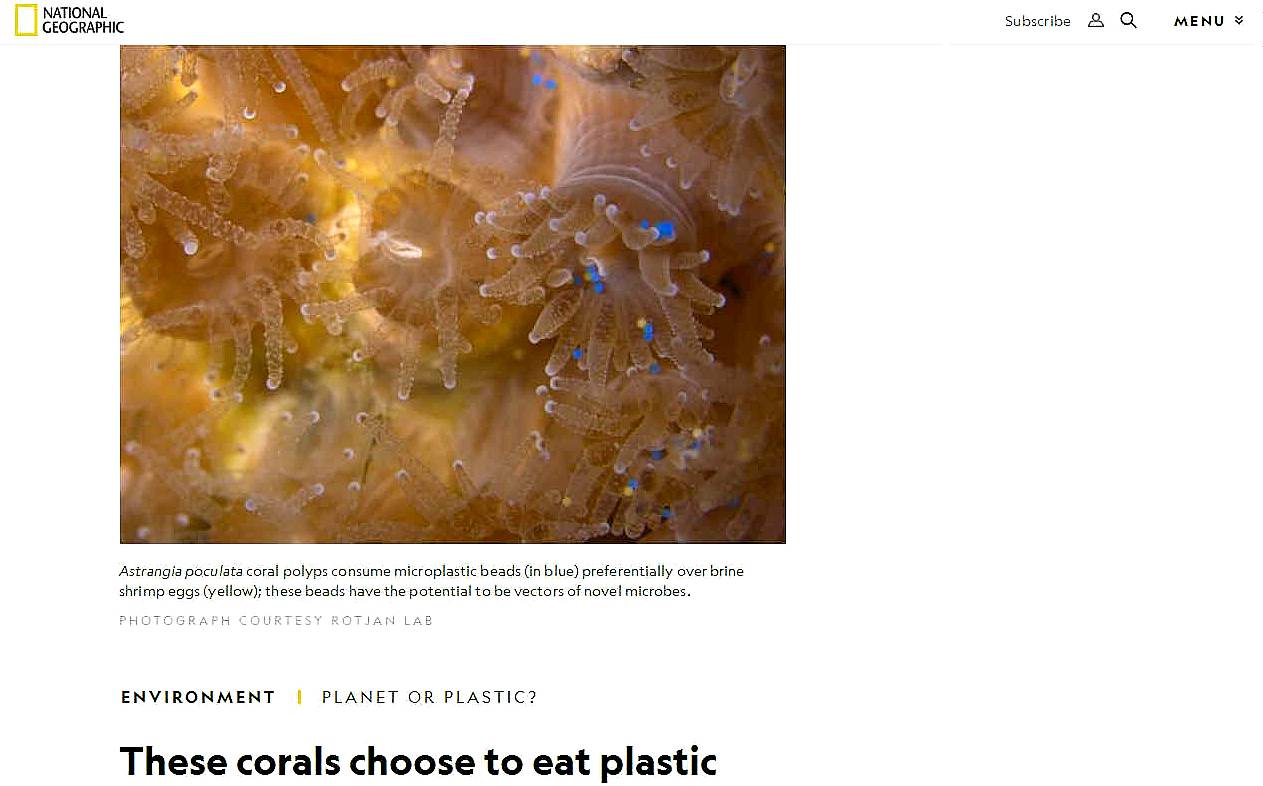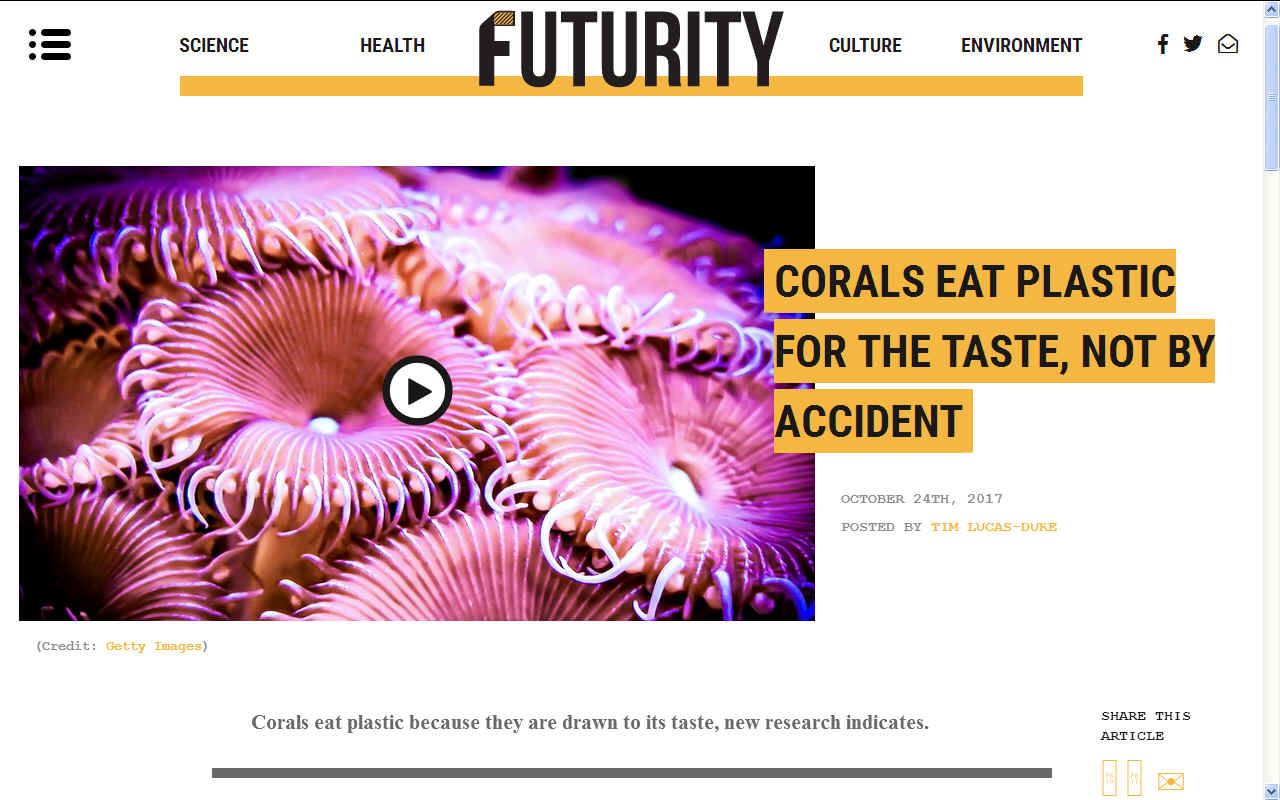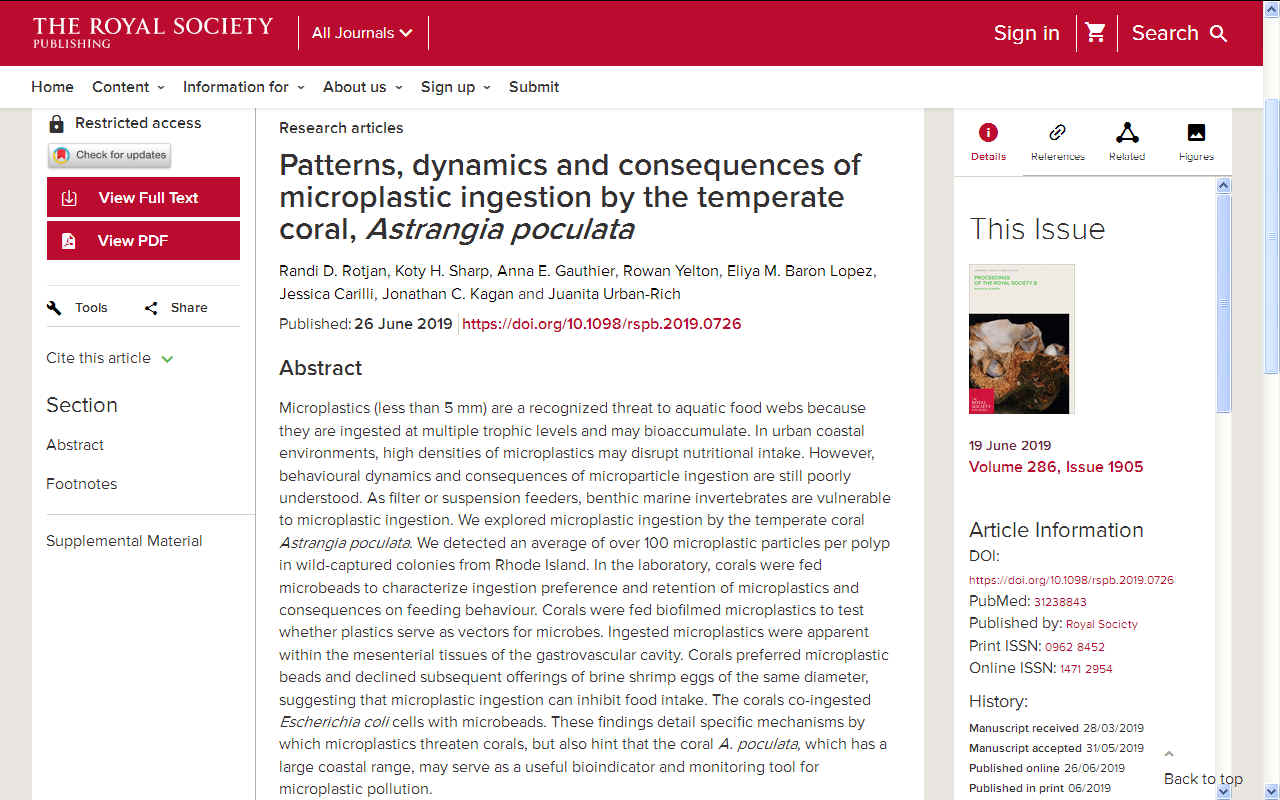|

Astrangia poculata coral polyps consume microplastic beads (in blue) preferentially over brine shrimp eggs (yellow); these beads have the potential to be vectors of novel microbes.
NATIONAL GEOGRAPHIC JUNE 25 2019 -
These corals choose to eat plastic over food
Tiny plastic particles may also be a vehicle for microbes that sicken or even kill corals, a new study finds.
Scientists have for the first time shown that some wild corals are feeding on tiny shreds of plastic trash. Worse, the animals seem to prefer those ‘microplastics’ over their natural food—even when the plastic is carrying bacteria that can kill them.
The new study, published in Proceedings of the Royal Society B: Biological Sciences, focused on a temperate species of coral collected off Rhode Island, one that builds small clusters no larger than a human fist. But researchers say the findings suggest that more familiar tropical, reef-building corals may also be consuming—and being harmed by—microplastics, which are defined as bits of plastic waste smaller than a fifth of an inch across.
The new results add to the growing sense that microplastics are ubiquitous in the environment, from tall mountain peaks to the deepest ocean trenches. Many organisms, from fish to birds, have been found to eat small bits of plastic. So do humans, through tainted water and food sources.
When Boston University coral biologist Randi Rotjan, who led the new study, first started working in marine ecosystems, she didn’t expect to be focusing on plastics. She was excited about studying corals and, as she puts it, having a conversation with nature.
“Plastics keep interrupting the conversation, and it’s hard to ignore,” Rotjan said. “You pick your ecosystem, you pick your organism, and you are most likely going to find
microplastics.”
Worse than junk food
Rotjan and her colleagues collected four colonies of wild Astrangia poculata, a small coral that lives off the U.S. Atlantic coast from Massachusetts to the Gulf of Mexico. They chose their study site, off the coast of Rhode Island, because it was close to an urban environment—Providence is 24 miles away—that could be expected to pollute the water with plastic.
Back in the laboratory, the researchers cut open the individual coral polyps and counted the number of microplastics. They found more than 100 small fibers in every polyp. Although this was the first record of microplastics in wild corals, earlier research had already shown that this same coral species consumed plastic in a laboratory setting.
The team also performed lab experiments. They presented lab-raised coral polyps with fluorescent blue microbeads—bits of plastic that until recently were used in soaps, cosmetics, and medications—at the same time as a natural food, brine shrimp eggs, which are also about the size of a pinhead.
Every single polyp that was given the choice ate almost twice as many microbeads as brine shrimp eggs. After those polyps had filled their stomachs with microbeads, which have no nutritive value, they stopped eating the shrimp eggs altogether.
“I was totally shocked by the results,” said co-author Jessica Carilli, a scientist at the Naval Information Warfare Center Pacific in San Diego, CA. “They aren’t just passively eating any particles that float within reach of their tentacles….They unfortunately preferred plastic to actual food.”
The U.S. government banned the use of microbeads in 2015, but the ban only went into effect a little over a year ago. Like other plastics, they will survive in the environment and pose a threat to corals for centuries.
Vectors of disease
In an additional feeding experiment, the researchers placed the microbeads in seawater to cover them with a biofilm—a thin layer of bacteria. In the ocean, explained co-author Koty Sharp, a coral microbiologist at Roger Williams University in Rhode Island, most microplastics are likely be coated with bacteria. The researchers laced the biofilm on their microbeads with the common intestinal bacteria E. coli, dyed fluorescent green to make them easy to track.
More than 48 hours after swallowing the microbeads, the polyps spit them back out. But even after that, the glowing E. coli persisted inside the coral’s digestive cavity. All coral polyps that ate the E. coli-laced microbeads died within two weeks.
“This is the most interesting part of the study. No one has looked at this vector of disease pathogens before,” said Joleah Lamb, an ecologist at University of California, Irvine who was uninvolved with the study. Lamb has surveyed hundreds of coral reefs, documenting disease and pollution by large plastic trash items. Her research, published in Science last year, found that disease in corals increased by 20-fold after plastic made contact with the corals.
Although E. coli is not common in the ocean, many other microbes are, and they seem to be concentrated on the surface of microplastics. Hitchhiking across the ocean on fragments of our trash, novel or harmful bacteria could be responsible for coral disease, researchers say.
Other corals may not respond to microbeads or the bacteria they carry in the same way; Rotjan’s team has studied just one species so far. But those early results, she said, are very concerning.
“I’m terrified of the mess we’ve created in our oceans,” Rotjan said. “But this is maybe part of the story for us to motivate cleaning it.”
By Jenny Howard

SCIENCEDIRECT.COM ABSTRACT - The drivers behind microplastic (up to 5 mm in diameter) consumption by animals are uncertain and impacts on foundational species are poorly understood. We investigated consumption of weathered,
unfouled, biofouled, pre-production and microbe-free National Institute of Standards plastic by a scleractinian coral that relies on chemosensory cues for feeding. Experiment one found that corals ingested many plastic types while mostly ignoring organic-free sand, suggesting that plastic contains
phagostimulents. Experiment two found that corals ingested more plastic that wasn't covered in a microbial biofilm than plastics that were
biofilmed. Additionally, corals retained ~ 8% of ingested plastic for 24 h or more and retained particles appeared stuck in corals, with consequences for
energetics, pollutant toxicity and trophic transfer. The potential for chemoreception to drive plastic consumption in marine taxa has implications for conservation.
FUTURITY OCTOBER 24 2017 - CORALS EAT PLASTIC FOR THE
TASTE, NOT BY ACCIDENT
Corals eat plastic because they are drawn to its taste, new research indicates.
Scientists have long known that marine animals mistakenly eat plastic debris because the tiny bits of floating plastic might look like prey, but the new study of plastic ingestion by corals suggests there may be an additional reason for the potentially harmful behavior: It just plain tastes good.
Visual cues, such as a resemblance to prey, don’t factor into the appeal, the researchers note, because corals have no eyes.
Tasty additives?
“Corals in our experiments ate all types of plastics but preferred unfouled microplastics by a threefold difference over microplastics covered in bacteria,” says Austin S. Allen, a PhD student at Duke University’s Nicholas School of the Environment. “This suggests the plastic itself contains something that makes it tasty.”
“When plastic comes from the factory, it has hundreds of chemical additives on it. Any one of these chemicals or a combination of them could be acting as a stimulant that makes plastic appealing to corals,” says Alexander C. Seymour, a geographic information systems analyst at Duke’s Marine Robotics and Remote Sensing Center, who co-led the study with Allen.
Further research will be needed to identify the specific additives that make the plastic so tasty to corals and determine if the same chemicals act as feeding stimulants to other marine species.
Microplastics, tiny pieces of weathered plastic less than 5 millimeters in diameter, began accumulating in the oceans four decades ago and are now ubiquitous in the marine environment. They pose a major threat to foraging sea animals, including many species of birds, turtles, fish, marine mammals, and invertebrates.
Because plastic is largely indigestible, it can lead to intestinal blockages, create a false sense of fullness, or reduce energy reserves in animals that consume it.
“About eight percent of the plastic that coral polyps in our study ingested was still stuck in their guts after 24 hours,” says Allen.
It can also leach hundreds of chemical compounds into their bodies and the surrounding environment. The biological effects of most of these compounds are still unknown, but some, such as phthalates, are confirmed environmental estrogens and androgens—hormones that affect sex determination.
Feeding chambers
Allen and Seymour conducted their two-part study using corals collected from waters off the North Carolina coast. In their first experiment, they offered small amounts of eight different types of microplastics to the corals to see if the animals would eat the bite-sized bits versus other similarly-sized items offered to them, such as clean sand.
“We found that the corals ate all of the plastic types we offered and mostly ignored sand,” Allen says.
In the second experiment, they put groups of coral into separate feeding chambers. Each group was offered the same amount of “food”—weathered plastics—for a 30-minute period, but some groups got only particles of unfouled microplastics while others got only particles of weathered microplastics fouled with a bacterial biofilm. This experiment verified that the corals would eat both types of plastic, but preferred the clean type by a three-to-one margin.
The researchers hope their findings will encourage scientists to explore the role taste plays in determining why marine organisms ingest microplastics.
“Ultimately, the hope is that if we can manufacture plastic so it unintentionally tastes good to these animals, we might also be able to manufacture it so it intentionally tastes bad,” Seymour says. “That could significantly help reduce the threat these microplastics pose.”
The researchers report their work in the journal Marine Pollution Bulletin.
The Oak Foundation funded the research. Source:
Duke University
LINKS
& REFERENCE
https://nicholas.duke.edu/about/news/taste-not-appearance-drives-corals-eat-plastics
https://www.sciencedirect.com/science/article/pii/S0025326X17306112?via%3Dihub
https://www.plasticsoupfoundation.org/en/2019/06/camera-in-wageningen-captures-coral-eating-plastic/
https://www.sciencedirect.com/science/article/pii/S0025326X17306112
https://royalsocietypublishing.org/doi/10.1098/rspb.2019.0726
https://www.nationalgeographic.com/environment/oceans/take-action/10-things-you-can-do-to-save-the-ocean/
https://nicholas.duke.edu/about/news/taste-not-appearance-drives-corals-eat-plastics
https://www.sciencedirect.com/science/article/pii/S0025326X17306112?via%3Dihub
https://www.plasticsoupfoundation.org/en/2019/06/camera-in-wageningen-captures-coral-eating-plastic/
https://www.sciencedirect.com/science/article/pii/S0025326X17306112
https://royalsocietypublishing.org/doi/10.1098/rspb.2019.0726
https://www.nationalgeographic.com/environment/oceans/take-action/10-things-you-can-do-to-save-the-ocean/

ROYAL SOCIETY ABSTRACT - Microplastics (less than 5 mm) are a recognized threat to aquatic food webs because they are ingested at multiple trophic levels and may bioaccumulate. In urban coastal environments, high densities of microplastics may disrupt nutritional intake. However, behavioural dynamics and consequences of microparticle ingestion are still poorly understood. As filter or suspension feeders, benthic marine invertebrates are vulnerable to microplastic ingestion. We explored microplastic ingestion by the temperate coral Astrangia poculata. We detected an average of over 100 microplastic particles per polyp in wild-captured colonies from Rhode Island. In the laboratory, corals were fed microbeads to characterize ingestion preference and retention of microplastics and consequences on feeding behaviour. Corals were fed biofilmed microplastics to test whether plastics serve as vectors for microbes. Ingested microplastics were apparent within the mesenterial tissues of the gastrovascular cavity. Corals preferred microplastic beads and declined subsequent offerings of brine shrimp eggs of the same diameter, suggesting that microplastic ingestion can inhibit food intake. The corals co-ingested Escherichia coli cells with microbeads. These findings detail specific mechanisms by which microplastics threaten corals, but also hint that the coral A. poculata, which has a large coastal range, may serve as a useful bioindicator and monitoring tool for microplastic pollution.
Randi D. Rotjan, Koty H. Sharp, Anna E. Gauthier, Rowan Yelton, Eliya M. Baron Lopez, Jessica Carilli, Jonathan C.
Kagan and Juanita Urban-Rich
|


